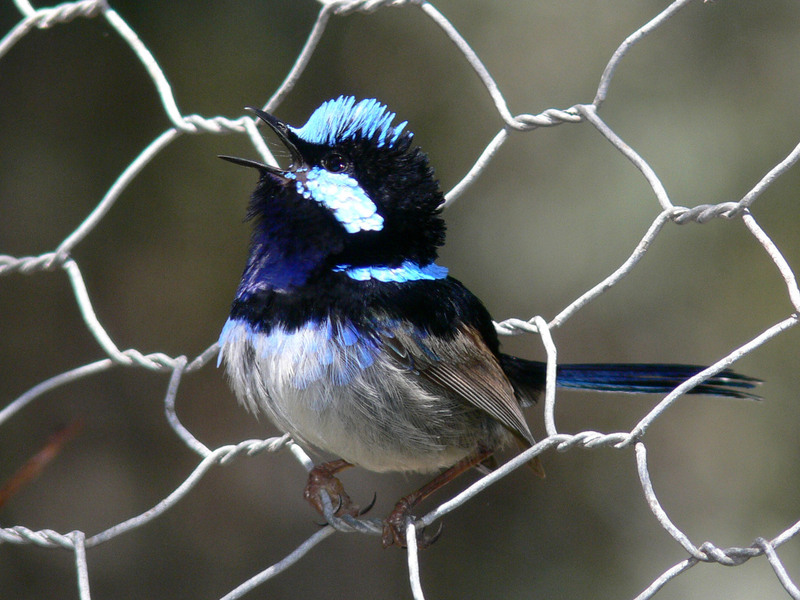|
| Query: malurus | Result: 1st of 82 | |
Superb Fairy-wren (Malurus cyaneus) - Wiki
| Subject: | Superb Fairy-wren (Malurus cyaneus) - Wiki
| |

| Resolution: 1600x1200
File Size: 505345 Bytes
Upload Date: 2007:01:17 21:49:56
|
ERROR : Server Busy(-1105)
ERROR : Server Busy(-1105)
Superb Fairy-wren (Malurus cyaneus) - Wiki
Superb Fairy-wren
From Wikipedia, the free encyclopedia
[Photo] Superb Fairy-wren (Malurus cyaneus) male. Taken by benjamint444 http://en.wikipedia.org/wiki/User:benjamint444
The Superb Fairy-wren (Malurus cyaneus) is the best-known of all fairy-wrens, and in south-eastern Australia is frequently known simply as the blue wren. Superb Fairy-wrens occupy wide range of habitat types, and are found in almost any area that has at least a little dense undergrowth for them to shelter in, including grasslands with scattered shrubs, moderately thick forest, woodland, heaths, and domestic gardens.
Distribution
The Superb Fairy-wren is common throughout most of the relatively wet and fertile south-eastern corner of the continent, from the south-east of South Australia, through all of Victoria, Tasmania, coastal and sub-coastal New South Wales and Queensland, as far north as the Brisbane area.
Ecology and behaviour
Like all fairy-wrens, the Superb Fairy-wren is an active and restless feeder, particularly on open ground near shelter, but also through the lower foliage. Movement is a series of jaunty hops and bounces, with its balance assisted by a proportionally large tail, which is usually held upright, and rarely still. The diet is a wide range of small creatures, mostly insects, supplemented by small quantities of seeds, flowers, and fruit. Both males and females sing a pleasant, complex song. Additionally, males possess a peculiar "Type II Vocalization"; this is not an alarm call (the usual series of sharp chits which is universally given and understood by small birds in response to predators). It is given in response to predatory birds calling, commonly Grey Butcherbirds, and it is song-like and given only once each instance (Langmore & Mulder 1992). The purpose of this behavior remains unknown; it has been proposed that it serves to announce male fitness (as it is not a warning call, but in fact gives away the location of the vocalizing male to the predator) but this is far from certain.
Another interesting habit of males of this and other fairy-wren species during the reproductive season is to pluck petals (in this species, yellow ones which contrast with their plumage) and show them to conspecifics (Karubian & Alvarando 2003). The obvious conclusion would be that this is a form of courtship (when directed at females) and/or antagonistic behavior (when directed at other males). However, research, while suggesting a courtship rather than antagonistic function of this behavior, has failed to show a good correspondence between petal-carrying and mating success in the related Red-backed Fairy-wren. It is notable that fairy-wrens are socially monogamous and sexually promiscuous: pairs will bond for a long time, but mate with other individuals. Young are often raised not by the pair alone, but with other males who also mated with the pair's female assisting. Thus, petal-carrying might be a behavior that strengthens the pair-bond. Petal carrying might also be a way for extra males to gain matings with the female.
Females, immatures, and non-breeding males are a plain fawn colour, lighter underneath, with the tail fawn (females and immatures) or dull greyish blue (males). Breeding males, however, take on rich blue tones around the head, chest and back.
http://en.wikipedia.org/wiki/Superb_Fairy-wren
| The text in this page is based on the copyrighted Wikipedia article shown in above URL. It is used under the GNU Free Documentation License. You may redistribute it, verbatim or modified, providing that you comply with the terms of the GFDL. |
|
Comments |
|---|
| | Guest |
|
| Superb Fairywren (Superb Fairy-wren) - Malurus cyaneus |
^o^
Animal Pictures Archive for smart phones
^o^
|
|
|